"St.
Augustine Catholic Church
(PAOAY
CHURCH
)"
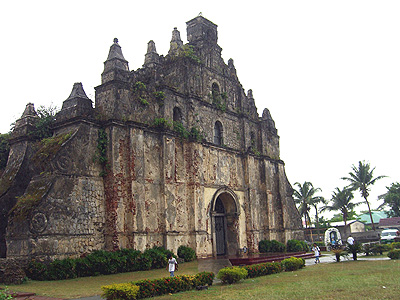 The
Paoay
Church
was built of coral blocks and stucco-plastered bricks. Its architecture is a
unique combination of Baroque and Oriental. The materials used for the walls
were a mixture of coral stone and bricks. Large coral stones were used at the
lower level of the walls, while bricks, smaller and more manageable to
transport, were used at the upper levels. The mortar used for the coral stones
and bricks points out the desire of the builders to make sure that the church
stood against natural calamities. The stucco was said to have been made by
mixing sand and lime with sugarcane juice, which were boiled with mango leaves,
leather, and rice straw. The church is considered as one of the most striking
edifices in the country with its huge buttresses flanking the sides and rear
facade.
The
Paoay
Church
was built of coral blocks and stucco-plastered bricks. Its architecture is a
unique combination of Baroque and Oriental. The materials used for the walls
were a mixture of coral stone and bricks. Large coral stones were used at the
lower level of the walls, while bricks, smaller and more manageable to
transport, were used at the upper levels. The mortar used for the coral stones
and bricks points out the desire of the builders to make sure that the church
stood against natural calamities. The stucco was said to have been made by
mixing sand and lime with sugarcane juice, which were boiled with mango leaves,
leather, and rice straw. The church is considered as one of the most striking
edifices in the country with its huge buttresses flanking the sides and rear
facade.
Viewed from the side, the giant buttresses look like huge volutes making the
facade appear as a massive pediment rising from the ground. The facade is
divided vertically by square pilasters that extend from the ground and all the
way to the top of the pediment. The facade is also divided horizontally by
cornices that extend all the way to the edges. The cornices extend to the sides
of the church and wrap each buttresses around, adding attention and articulation
to the massive side supports.
The facade is complemented with a bell tower located at its right hand side.
Bell
towers are a very important element in the overall composition of colonial
churches, both for its function and aesthetics. For practical purposes,
belltowers were used as a communication device to the townspeople. In the case
of the Paoay bell tower, it also played, ironically, an explicit role in the
lives of the Filipinos during the war. It has been said that the bell tower was
used as an observation post by Katipuneros during the Philippine Revolution and
by guerilleros during the Japanese occupation.
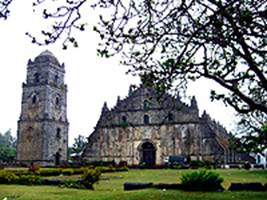

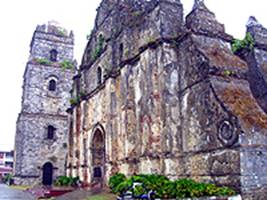
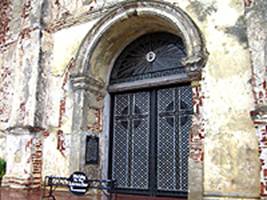

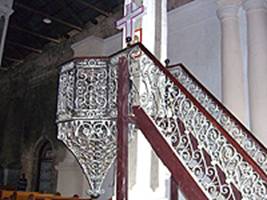
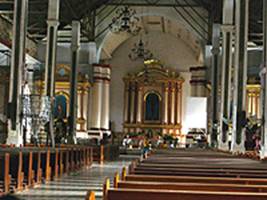
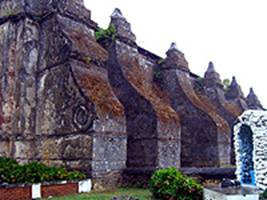



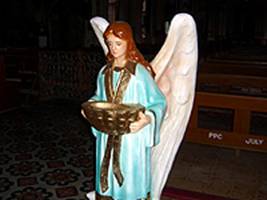
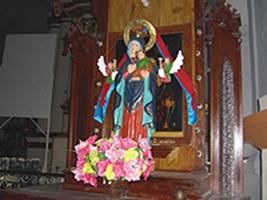
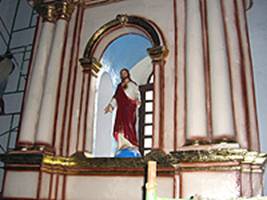
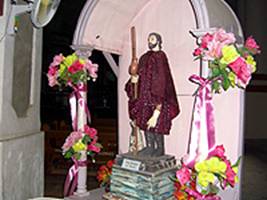
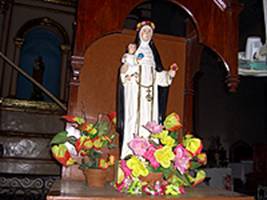
The
Paoay
Church
was started by the Augustinian Fr. Antonio Estavillo. Cornerstone laying for
the church was made in 1704, its convent in 1707, and the bell tower in 1793. It
was completed in 1710 and nauguration ceremonies were held on February 28, 1896,
just three years before the expulsion of Spanish rule in the country. The style
of the church has been dubbed an “Earthquake Baroque.” The church started to
be used before its completion and kept in repair by the people under the joint
auspices of the Church and the town officials of Paoay. The church was badly
damaged by earthquake in 1927 and lated included in the UNESCO'S World Heritage
List.
Compared to its still magnificent exterior, the
Paoay
Church
looks austere and stark inside, with but a few old images of saints and a
simple wooden cross at the altar, that it is hard to imagine now how it looked
like a hundred years ago. Only on Sundays does the Parish enjoy quite a number
of worshippers. It is sad to note that on any other day, except for an
intermittent bus loads of Taiwanese tourists, the church suffers from the lack
of patronage.
 The
The  The
The